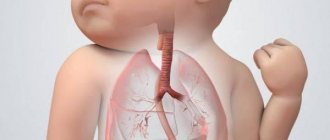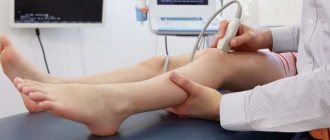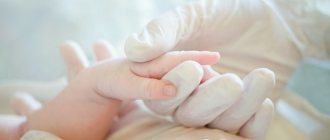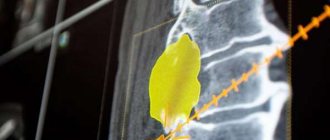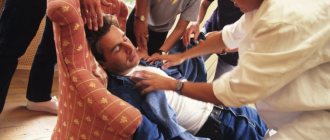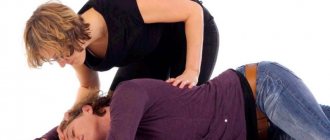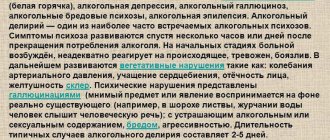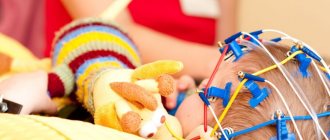Convulsions in children at any age develop when a focus of pathological excitation appears in the brain, and is accompanied by the sudden appearance of local or generalized convulsions of different nature.
Most often, seizures in infants are associated with significant immaturity of the central nervous system and the lack of its stable connections with other body systems. Also, excitation processes in neurons in young children are more active than inhibition.
Gradually, everything returns to normal, therefore, after the first manifestations of convulsive syndrome, it is important to promptly seek medical help and determine the cause of the development of seizures in the child.
Cramps in young children are involuntary contractions of individual muscles or their groups, which can last from a few seconds to several days.
Seizures in most cases are associated with the active damaging influence of various harmful factors on the cells of the baby’s brain or spinal cord:
- during the period of its intrauterine development;
- during childbirth;
- in the first months or years of his life.
Most often, convulsive syndrome develops during the neonatal period or in children under three years of age.
Seizures are classified:
By the nature of muscle contractions:
- convulsions are tonic in nature, which are contractions or, conversely, relaxation of the muscles of the limbs, face or neck in a certain position: extension or flexion of the limbs; a sharp relaxation of the muscles (atony) may also be observed, causing a sudden fall and immobilization of the child;
- clonic convulsions are characterized by a sudden contraction of individual muscle groups of the legs, arms or torso in the form of rapid involuntary twitching or development of movements in the limbs;
- clonic-tonic convulsions.
According to the volume and completeness of involvement of skeletal muscles in the convulsive process:
- partial (local) seizures;
- generalized convulsions or generalized convulsive attack.
Also, in young children, febrile and respiratory-affective convulsions are distinguished as separate types of seizures.
Febrile seizures in infants
Febrile seizures occur in children from six months to five or six years of age (more often these are seizures in children under one year or from one to three years).
An attack of febrile convulsions in children occurs against the background of a high temperature, but provided that the baby has not previously had convulsions and without signs of infectious or toxic damage to the central nervous system.
This type of seizure is associated with anatomical and functional immaturity of the nervous system and instability of the thermoregulation center.
A genetic predisposition to the development of seizures is also considered one of the important factors.
Features of febrile seizures:
- simple, one-time convulsions that occur against a background of high temperature (hyperthermic syndrome) - above 38 degrees;
- their duration is no more than five to ten minutes;
- less often they occur in series, lasting no more than 15 minutes;
- the child has no changes in neurological status - no focal neurological symptoms.
For febrile seizures:
the baby holds his breath, turns blue or pale, the child often has cramps in his legs with straightening and/or twitching of the limbs, he can completely withdraw from the outside world.
Respiratory-affective convulsions
Respiratory-affective convulsions (fits) occur in children between six months and three years of age due to the manifestation of strong negative emotions.
This attack is considered a kind of hysterical reaction to the influence of negative factors that cause emotional shock in the baby.
This type of seizure is accompanied by loud crying or screaming of the child. At the height of the seizure it is noted:
- breathing disorders (apnea or dyspnea) with facial cyanosis;
- dilated pupils;
- simple tonic or clonic convulsions often occur;
- Less commonly, a generalized attack with tonic-clonic convulsions develops.
Seizures in newborns
In the first days of life, a baby (even a child under five years old) can often experience seizures.
Sometimes spasms indicate the presence of serious pathologies in a child under one year old. Let's consider the most typical causes of seizures in children under one year of age, signs and possible methods of treatment. The phenomenon often occurs in premature babies - up to three to five years of age. Statistics say that every fifth premature baby is subject to some degree of seizure syndrome. Mothers who gave birth to a premature baby need to be attentive to his health.
Signs of a seizure
In medical science, specific symptoms are identified for each type of infant spasm. In addition, there are general signs of the disease. It is important to know what symptoms accompany convulsive syndrome in order to identify the disease in time and seek help from a doctor. Convulsions in infants manifest themselves as follows:
- chin trembles and moves;
- there is a feeling that the child is chewing something;
- facial muscles and eyelids twitch;
- Babies often roll their eyes;
- limbs move rhythmically;
- arms and legs constantly twitch during sleep;
- breathing is disrupted (even to the point of stopping) and heart rhythm;
- the child hiccups and constantly yawns due to lack of oxygen;
- spasms in premature babies are accompanied by a sharp and loud cry;
- vomiting and nausea appear;
- an attack of convulsions occurs after excessive physical activity of the child.
Other symptoms of the disease include blue skin, increased body temperature, and loss of consciousness. These conditions are especially dangerous when newborns are sleeping. Parents should know what the symptoms of seizures in children look like and monitor the child’s condition to avoid dangerous consequences.
Types of seizures in newborns and children under three years of age
In children under one year of age, in older children (up to three and five years old), seizures show a different character. The latter is associated with the peculiarities of the functioning of the brain and nervous system (the nervous system of newborn children is at the stage of formation). Doctors divide seizures up to three years into a number of types.
- Minor convulsions (spasms). Dangerous, considered to be a harbinger of the development of a dangerous disorder of brain development. The phenomenon is easy to identify - minor twitching or blinking of the eyes, facial muscles, skeletal muscles. Sometimes a slight, unexpressed blue discoloration of the skin is noticed.
Our services
Photo: shutterstock. Why is this happening and is there any cause for concern? Babies sleep 9 hours during the day and 8 at night. Most babies under 3 months of age wake up frequently during the night because their stomachs are still small and they have to wake up every few hours to feed. The recommended daily dose of milk for children under 6 months is ml per kilogram of weight.
Forum Children under one year old. Create a topic Sections.
Author: Smelov Yuri Olegovich Rehabilitologist, employee of the clinic of neurology and manual therapy. Site search. Socialization Center Socialization Preschoolers. Junior schoolchildren. I read books! High school. Successful and famous. Career guidance resources. Education in the world.
Is it possible to independently determine the nature of seizures in a newborn and a child under three years of age?
The manifestations of seizures in children under one year of age are ambiguous and differ in a particular case. Parents will not be able to independently determine the nature of a seizure in a child without medical help, relying solely on their own experience or on information gleaned from medical sources. Not in every case, rhythmic muscle twitching is considered a seizure.
Seizures in a newborn and a child under three years of age are determined exclusively in a hospital setting. Doctors use the latest diagnostic methods, in particular electroencephalography and magnetic resonance imaging. In the presence of small seizures, it is difficult to observe the dynamics of changes in brain activity.
It often happens that seizures do not respond to anti-epileptic drugs. The latter means that the previous diagnosis was made inaccurately, the child needs to be re-diagnosed.
Causes of illness
There are many prerequisites for illness, and only the attending physician can understand them. After all, the range of syndromes is quite wide - from muscle contractions when falling asleep and during sleep to epileptic seizures. Night cramps in children are not always classified as pathologies, because impulses to the nerve endings can arrive as a result of vivid sleep or uncomfortable posture.
Convulsions in children under one year of age are also explained by the rapid excitability of the central nervous system (CNS) due to its immaturity.
Such reactions in children are divided into epileptic and non-epileptic. Risk factors for the latter include:
- Hereditary disposition;
- Psycho-emotional disorders;
- CNS dysfunctions;
- Traumatic brain injuries;
- Metabolic disease;
- Heat;
- Reaction to vaccination;
- Intoxication of the body;
- Internal hemorrhages.
The cause of leg cramps in a child can be a deficiency of calcium, iron and magnesium. In a newborn, seizures can occur due to asphyxia, birth injuries, problems with the heart and blood vessels, and perinatal encephalopathy.
What are respiratory affective seizures? These are involuntary muscle contractions due to excess emotions. They usually appear in babies from six months to three years and are considered the most harmless.
Only a doctor can determine the cause of seizures. If they are accompanied by other painful symptoms and recur frequently, medical attention is necessary.
Causes of neonatal seizures
There are many reasons for seizures in young children. Let's look at the common and typical ones.
- Metabolic disorders of various etiologies. These primarily include hypoglycemia and hyponatremia. With hypoglycemia, there is a decrease in the amount of sugar in the blood. The condition often leads to seizures in the child. Remain attentive to the child’s condition; in some cases, hypoglycemia leads to irreversible consequences in the cerebral cortex. Low calcium levels in the blood (hypocalcemia) also negatively affect the functioning of the brain and lead to seizures.
- Encephalopathy. Brain damage is manifested by acute or chronic lack of oxygen in the blood.
- Meningitis and encephalitis pose a huge danger to the newborn’s brain and are considered a serious cause of seizures.
- Damage to the blood vessels of the brain, often found in premature infants. Threatens cerebral hemorrhages.
- Insufficiency of magnesium or pyridoxine (vitamin B6) in the child’s body. Often pathologies develop simultaneously.
- Birth injury.
- Congenital brain defects in children.
- When treated with psychoactive drugs, seizures occur as a withdrawal syndrome.
Symptoms of seizures in children of the first year of life
Conditions that cause seizures in newborns are often life-threatening. There are cases where children with convulsions in the neonatal period subsequently developed without any special complications. If seizures occurred due to low glucose levels in the baby’s blood, the child also did not develop complications in the future. If the spasms occurred as a result of meningitis, a high risk of developing all kinds of neurological complications is subsequently revealed.
According to clinical symptoms, seizures are classified as partial, localized, and generalized. In the first case, they spread to a specific muscle group. In the second case, a general convulsive seizure develops. A generalized type of seizures develops when both hemispheres of the brain are involved in the painful process.
If there is a recurrence of convulsive seizures, they speak of convulsive status. Breathing disturbances occur with symptoms of hypoxic cerebral edema. When edema spreads to the brain stem, a disorder of the respiratory, vasomotor center, pathological breathing, vomiting, increased temperature (even up to 39 degrees), bradycardia, and collapse occurs.
A generalized tonic-clonic seizure develops suddenly. Disturbing motor excitement, depression of consciousness up to loss. Characterized by tilting the head back, bending the arms at the elbow joints, straightening the legs, and tense the face. Possible apnea (stopping breathing), the face becomes pale and blue. Vomiting is observed. Holding your breath lasts no more than a minute. After the end of the seizure, the body is completely restored, and the same happens with consciousness. The child does not remember what is happening at all. The prognosis noticeably worsens if paresis or paralysis is observed along with convulsions.
Often, infants experience short-term generalized tonic-clonic seizures. They are typical in children under one year of age, but can occur in older children. It happens against the background of a rise in body temperature. The duration of convulsions is no more than three to five minutes. The prognosis is favorable, not accompanied by neurological disorders. The nervous and mental health of children does not suffer, does not lag behind, and is completely appropriate for their age.
With a lack of calcium in the blood, tetanic convulsions and attacks of sudden respiratory arrest occur. Specific symptoms are noticeable:
- Contraction of the orbicularis oculi muscle;
- Contraction of the angularis oris muscle;
- Abduction of the foot when tapping the forearm or shoulder;
- Laryngospasm.
- Vomit.
The main principles of treating seizures in infants
Successful treatment of any seizure in a newborn becomes such once the cause is discovered. General rules for the treatment of convulsive conditions in children:
- If hypocalcemia is the cause of a convulsive state, the child is given a solution of calcium gluconate in a glucose solution (slowly and intravenously).
- For hypomagnesemia (magnesium deficiency), a solution of magnesium sulfate is injected intramuscularly.
- In case of hypoglycemia, a dextrose solution is first administered, then a glucose solution is administered in a stream and intravenously. It is necessary to monitor temperature and vomiting.
- In febrile convulsive conditions, the first step is to effectively control the fever.
Newborns diagnosed with seizures are admitted to the intensive care unit. The nurse's job is to carefully monitor the baby's condition. An electroencephalogram is also performed there to determine the state of the brain and the functioning of the organ. Based on electroencephalography indications, therapy adjustment is recommended.
If a baby under one year of age has convulsions that frequently recur and become persistent, the use of barbiturates—barbituric acid derivatives—is indicated. Barbiturates have a hypnotic and sedative effect, which is necessary for the development of seizures. The use of short, medium and long-term drugs is indicated depending on the case. Long-term action of barbiturates is required for the treatment of severe epileptic seizures.
In case of respiratory failure, loss of consciousness, fever and periodic vomiting, it is recommended to maintain artificial ventilation of the lungs and blood pressure. Pressure is maintained using special medications. It is necessary to constantly stop convulsive paroxysm due to the considerable danger to the heart. Respiratory disorders and persistent impairment of consciousness are absolute indications for urgent etiotropic therapy combined with symptomatic anticonvulsant treatment.
Due to the fact that in the neonatal period of a child’s development (especially at the age of several months) it is difficult to detect the true cause of the development of an epileptic seizure, a third of children die. Death is associated with severe complications of seizures: ischemic encephalopathy, ischemic stroke. The prognosis for meningococcal infection is extremely poor. When caused by metabolic disorders, seizure syndromes usually have a good prognosis.
The child must be under the supervision of a pediatrician from the first month of life for at least a year. It is necessary to conduct a complete and comprehensive examination of the functioning of the baby’s nervous system in order to prevent the development of serious neurological disorders.
Convulsions in newborns are recognized as the object of close attention of parents and doctors. It is extremely important to immediately determine the cause of seizures in order to begin effective treatment. And although certain types of seizures do not have a very favorable prognosis, they can be treated effectively. Especially if the parents consulted a doctor at an early stage of the disease.
First aid and treatment
Treatment of seizures in infants has its own characteristics. It is carried out in a hospital under the close supervision of a doctor. Drug therapy is usually prescribed, aimed at stabilizing the body's metabolic processes. It is important to relieve convulsive syndrome. For this purpose, barbiturates are prescribed, which have a depressant effect on the nervous system. Motor activity and anxiety are relieved with the help of sleeping pills and sedatives. In more severe cases of illness, mechanical ventilation may be required. If the attack is severe, urgent medical attention is required. To alleviate the baby’s condition before the ambulance arrives, it is necessary to free him from clothes and diapers. You cannot influence the child in any way during seizures or give him medications. Treatment must be comprehensive. The rehabilitation period can last several years. The completed course does not guarantee the baby’s complete recovery. Disorders present in infancy often have long-term consequences in the future.
Classification of seizures
Newborn seizures should not be combined into one group, because they have different characteristics. Doctors associate the difference between the types with the peculiarities of the functioning of the child’s brain and nervous system, which at this age are not yet fully formed.
The following types of seizures in newborns are distinguished:
- Minor cramps or spasms. Despite this diminutive name, this type of seizure is very dangerous. After all, they portend that the baby has quite serious disorders in the functioning and development of the brain. This type is easily determined - minor twitching or blinking of the eyes. Weak tics of the muscles of the face and skeleton. Not very pronounced bluing of the skin;
- Tonic convulsions. It is expressed in the fact that during attacks in a newborn, the whole body tenses in a characteristic position: it unbends, and the head is thrown back. Brief holding of breath (apnea) is possible. The attack lasts no more than a minute. Premature babies are most often affected. At the same time, they may have manifestations of seizures up to the age of three;
- Clinical seizures. Unlike the above tonic ones, this type of convulsions never occurs in premature babies. Clinically characterized by the fact that a child’s body twitches with a contraction frequency of 1-3 per second. In turn, clinical ones are divided into: focal or patchy, multifocal (multispectacle) and generalized. The latter are characterized by loss of consciousness. Cyanosis of the skin and respiratory rhythm disturbances;
- Myoclonic spasms. Quite rare. They appear in most cases in older children. Symptoms – the child’s entire body, or some individual limb, twitches sharply. In rare cases, seizures can be of a mixed type - when the baby twitches at the same time, for example, the head and hand. This type of seizure should alert parents, as it is evidence that the newborn has serious brain damage. Hereditary or congenital type.
Congenital diseases of the central nervous system
This is what parents fear most. Such actions may include small convulsions or spasms, which may cause the face and eyelids to tremble. The eyes roll back, the pupils move apart or converge. Such signs are a serious reason to visit a neurologist.
Premature babies are more susceptible to seizures caused by central nervous system disorders. In newborns who were in the womb for the entire period, 10-15 examples out of 1000 are recorded.
Minor seizures occur as a result of:
- Trauma during childbirth.
- Increased ICP.
- Oxygen starvation during asphyxia.
- Anomalies of brain formation. Seizures may relate to pathologies such as porencephaly and epileptic seizures.
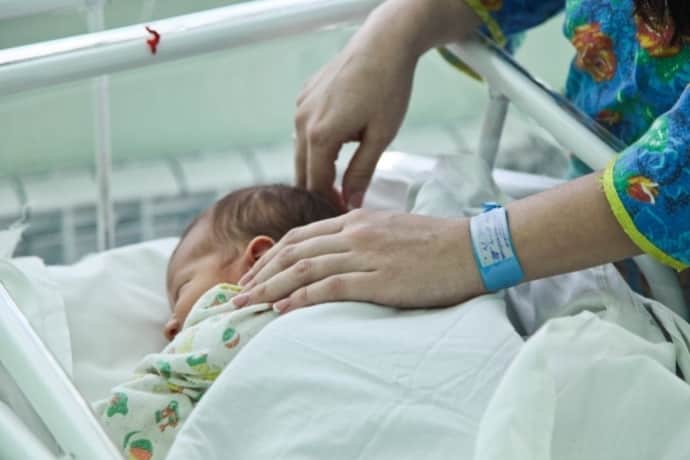
Possible causes of seizures
Among the causes of seizures in infants are the following:
- Prematurity is considered a major factor, since all children diagnosed are automatically at risk;
- An increased level of norepinephrine in the blood may also indicate that the baby may have seizures;
- Intrauterine hypoxia due to entanglement with the umbilical cord can further cause seizures. Since brain cells and nerve endings cannot undergo full formation because of this;
- The woman was constantly under stress during pregnancy;
- The expectant mother suffered an infectious disease in the first or third trimester of pregnancy. The most dangerous infections are cytomegalovirus or toxoplasmosis.
Diagnostics
It is not always possible to identify some types of disease in an infant at first glance. If the syndrome is not accompanied by an external change in the baby’s condition or serious respiratory dysfunction, it may go unnoticed for a long time. In addition, a newborn is characterized by various movements and twitching of arms and legs, especially during sleep. The pathological condition is identified by a pediatrician based on an examination of the baby for the presence of alarming symptoms. The appearance of specific signs serves as a basis for consultation with a neurologist. Disruption of brain activity and the appearance of convulsive syndrome are diagnosed using an electroencephalogram. But if the baby has minor seizures, this test may not detect them. It is necessary to analyze the general condition of the small patient. If this disease occurs, the symptoms are manifested by a variety of characteristic signs that significantly limit the life activity of the newborn. One symptom very rarely indicates illness.
Symptoms of seizures
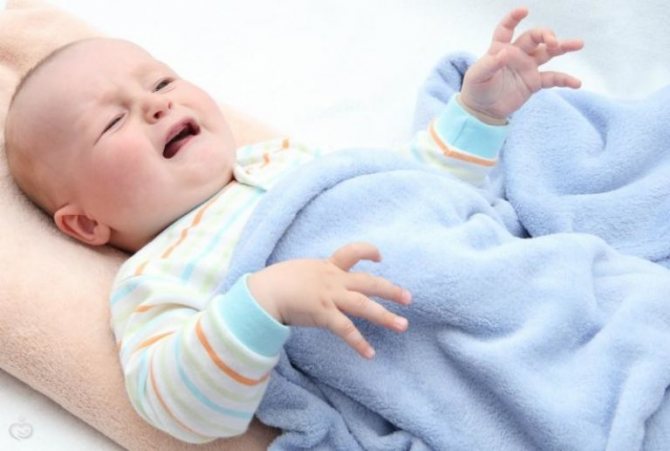
In most cases, the first signs of seizures in newborns appear literally immediately, within the first day after birth. They are easily identified, but adults should carefully monitor the baby’s condition and take the necessary measures if the following symptoms appear:
- Twitching of eyelids;
- Trembling chin;
- The baby's jaw makes movements that can be mistaken for chewing food;
- Rhythmic twitching of the muscles of the legs and arms;
- The rhythm of breathing and cardiac activity is sharply disrupted. Sometimes breathing may completely disappear for a short time - apnea;
- The child rolls his eyes for no reason.
But parents should remember that not every tic is a manifestation of seizure syndrome in newborns. In general, in children under three years of age, seizures can only be determined in a hospital setting. Using the latest diagnostic techniques.
My legs are shaking
All parents are concerned about the health of their baby. They look especially closely at the child in the first weeks and months after his birth: is everything okay with his beloved baby? If the child is the first, then mothers and fathers may not know about some of the features of its development, and sometimes they are surprised or even frightened by the most ordinary phenomena. What most often worries young parents? Yes, this is hypertonicity - increased tone of the flexor muscles, but this is a completely normal phenomenon that all babies have up to a certain age. If you look at a newborn, you can see that his arms are bent at all joints, brought to the body and pressed to the chest, his hands are clenched into fists, his thumbs lie under the other four. The baby's legs are also bent at the joints and abducted at the hips; dorsiflexion predominates in the feet. Muscle tone in the arms is usually higher than in the legs.
Berry again. How to reduce the symptoms of menopause.
Treatment
Most often, general non-drug therapy is used to treat diseases of a neurological nature. And only in cases where the seizures have a pronounced form, medications are used. Usually this:
- To normalize metabolic processes: magnesium, glucose or calcium gluconate;
- Convulsive syndrome is relieved by barbiturates;
- Motor restlessness is relieved by sedatives and sleeping pills.
If signs of seizures in an infant were noticed in a hospital setting, then there should not be any special problems with treatment. What should parents do if seizures begin at home? After discharge from the maternity hospital. If the attacks are mild and go away immediately, then the visit to the clinic can be postponed until the next day.
But when convulsions in newborns are severe, he recommends calling an ambulance immediately. And take some measures before her arrival. For example, free the child from clothes (unswaddle). Thus ensuring free access of air. At the same time, it is not recommended to bother the child or give any medications, especially when an attack is underway.
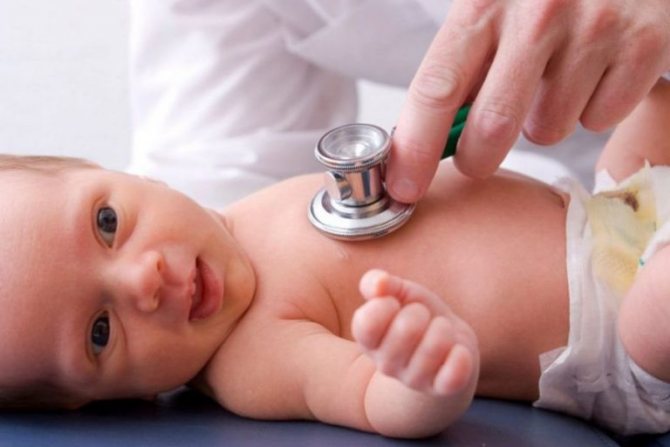
In severe cases, all treatment occurs in a hospital setting. But even after this, the baby must be under the supervision of a neurologist for at least a year. And undergo recovery procedures at home:
- Therapeutic massage supplemented with gymnastics;
- Regular walks in the fresh air are necessary. It is also recommended to harden the baby;
- Strictly follow the daily routine;
- Avoid stress in your child's life. This requires a calm environment in the family.
Preventive measures
It is better to prevent any illness than to treat it later. And it’s the same with convulsive manifestations. In addition, the prognosis for recovery in infants is not always favorable. And not because medicine is powerless. The reason is that the disease is detected late. Therefore, it is better to prevent. Moreover, for this, it is enough for mom to follow a few simple rules:
- A couple of months before the planned conception, start taking folic acid;
- During pregnancy, avoid infections. You should not take any medications without the permission of your gynecologist;
- After birth, have your baby examined by a neurologist as soon as possible.
How do seizures manifest in infants?
Every parent wants their child to be alive and healthy, protected from all illnesses. But this is not always in their control, and malfunctions or uncontrolled conditions are possible in the baby’s body, an example of which is seizures.
Seizures in newborn babies are not as rare as they might seem and account for up to 1% of all ailments. Quite often, these conditions may indicate some problems in the body. From the article you can learn how to recognize convulsive conditions in infants, what to do in such cases and how to prevent their occurrence.
Causes
Usually convulsive reactions appear suddenly, the main reasons for their appearance are as follows:
- Head injuries, tumors, etc.;
- Infection (viral or microbial disease: meningitis, herpes, kernicterus, sepsis, rubella, cytomegalovirus, toxoplasmosis, etc., especially if the nervous system is affected);
- Intoxication with poisons, harmful substances;
- Metabolic disorders that affect the functioning of the nervous system;
- Diseases of the nervous system, inflammatory processes, hypoxia, circulatory disorders, etc.;
- Birth injury;
- Heat;
- Vaccinations;
- Genetic predisposition;
- Epilepsy.
Description of the disorder
Cramps refer to uncontrolled contractions of muscle tissue, which can vary in duration and intensity. Why do they appear? These processes are controlled by the brain. Biochemical interaction always occurs in nerve cells, and excitement appears.
After this, the neurons transmit impulses to muscle tissue, requiring work and contraction. Not all excitations in neurons are transmitted to muscle tissue. Often the brain tries to restrain natural processes, so impulses from nerve cells do not pass to muscle tissue.
Parents often mistake body movements for seizures that are not related to various spasms. There are several normal conditions to consider:
- The child twitches sharply in his sleep. The central nervous system in infants is not yet fully formed. Such impulses are a signal that the process of debugging the functioning of the brain is underway.
- The chin shakes, the lower lips and limbs tremble when the baby cries. This also affects the functioning of the nervous system.
- Breathing is delayed. Sometimes you can observe how a child does not take a breath for a long time during sleep or pauses before exhaling. This condition also does not apply to convulsive ones.
- Convulsions appear abruptly, most occur during wakefulness. The contractions look unnatural. With light focal contractions, the child freezes and looks in one place. This condition refers to muscle spasms.
- Sometimes newborns lose consciousness, sometimes they don't. During a seizure, the child uses unnatural, bizarre postures, involuntary urination or bowel movements occur, and breathing stops.
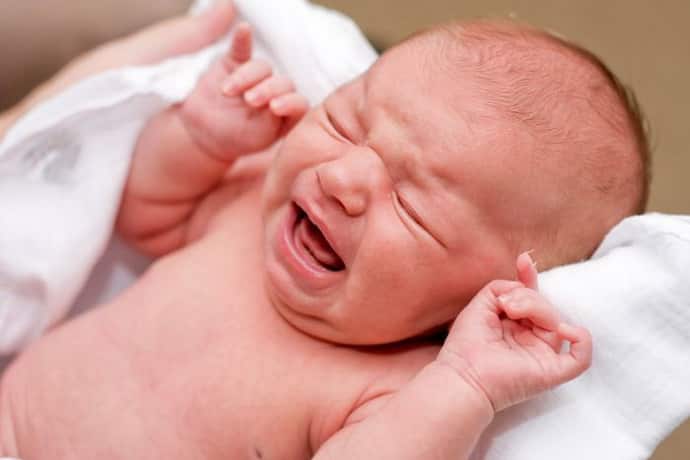
To distinguish seizures from ordinary shudders, you need to carefully watch the child’s actions. Only muscle spasms are addressed.
Symptoms
The tendency of newborns to such reactions can be explained simply by the insufficient maturity of the nervous system, which is easily excited by the many internal and external impulses coming to it, but it can also turn out to be a serious signal of the development of pathological processes.
It is not difficult to identify convulsions in a baby - they manifest themselves externally:
- The muscles of the arms and legs twitch rhythmically;
- Movements similar to chewing appear;
- The eyes deviate toward the nose or outward, and may roll upward;
- Your heart rate or breathing rate changes unexpectedly.
Treatment
It is important to correctly assess the situation; much of the actions taken depend on the seriousness of the situation and the severity of convulsive phenomena. If everything is more serious, then it is necessary to call an ambulance, even if the attack is over and the child has fallen asleep. Until the ambulance arrives, you need to do the following:
- Place the baby on a flat, hard surface with the head lying on its side;
- Place a piece of cloth in your mouth;
- Free yourself from clothes that hinder movement;
- If the baby stops breathing, after stopping the attack, you need to do artificial respiration;
- To allow air access, open windows and doors;
- You cannot shake or disturb the child;
- If an attack of convulsions is caused by a high temperature, you need to reduce the fever, give the baby an antipyretic drug, use everything available for physical cooling: wipe with a damp sponge, remove clothes, fan with a rag (but do not rub the child with alcohol or vinegar - this will increase heat transfer and aggravate the attack).
In the hospital, the baby is examined as quickly as possible and the necessary assistance is provided (restore the water-salt balance, improve brain nutrition, etc.). If convulsions do not go away, seduxen or phenobarbital may be prescribed. Next, the child is observed by a pediatrician.
First aid
Regardless of the cause of the seizures, whether they are provoked by physiological characteristics or vaccines, the doctor will have to help ease the child’s well-being and prevent injuries. You need to try to calm down and write down all the symptoms that appear, so that you can then describe them to specialists and determine the nature of the seizures.
The baby should be placed on his back, a pillow that is not too voluminous should be placed under his head, the upper part of the body should be freed from clothing so that breathing is not difficult. You need to provide air flow and gently hold their head. When the seizure subsides, you need to contact an ambulance.
When the seizures do not recur, the child feels normal, and the parents know the cause of the disorder, a visit to a specialist can be postponed until a convenient time, but it will still have to be done.
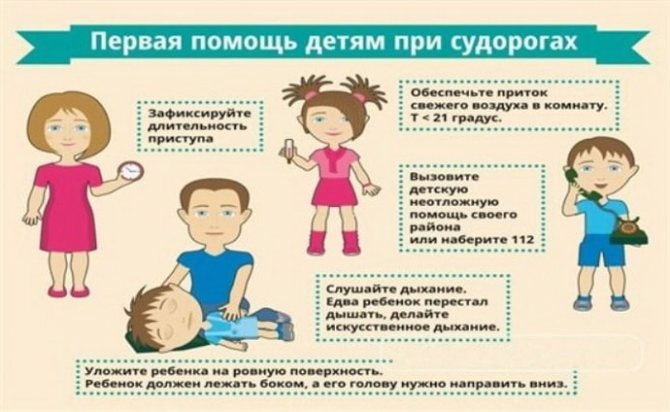
Prohibited during seizures:
- Shake the baby or press hard on him.
- Try to hold his arms or legs.
- Provide artificial respiration.
- Lay on your back.
- Try to unclench your teeth and put something in your mouth.
If the reasons are known to everyone, you need to do the following:
- During respiratory spasms, you need to sprinkle the baby’s face with cold liquid and bring ammonia to the nose.
- If febrile convulsions develop, the body is covered with a cold rag, when the seizure stops, you need to give the child an antipyretic drug.
- You need to give your baby more fluids.
Prevention
- Expectant parents should take folic acid (daily dose - 400 mcg) about three months before the planned pregnancy - this will increase the chances of having a baby with a nervous system without pathologies;
- During pregnancy (especially harmful up to 8 weeks), the expectant mother must avoid harmful influences (infections, x-rays, taking medications without special reasons, etc.);
- After childbirth, a routine examination by a neurologist is necessary; when the baby is one month old, neurosonography is useful (the brain is examined using ultrasound through the fontanelle).
What is the normal level of intracranial pressure - detailed studies.[/tip]
It happens that convulsions occur when a child sobs or screams loudly. In such cases, it is necessary to restore breathing: you can sprinkle some water, give a little ammonia, and then give a sedative.
